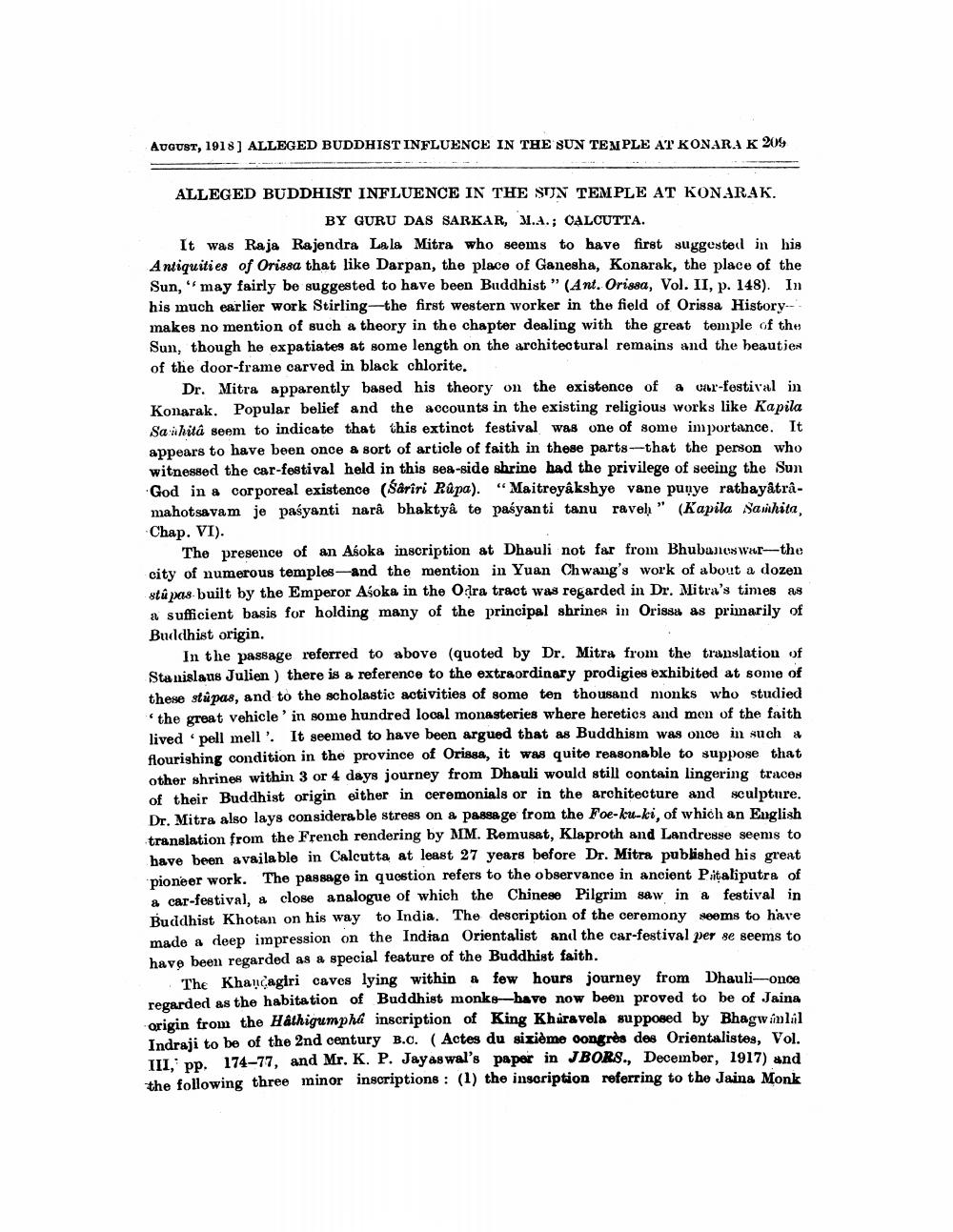________________
August, 1918) ALLEGED BUDDHIST INFLUENCE IN THE SUN TEMPLE AT KONARA K 205
ALLEGED BUDDHIST INFLUENCE IN THE SUN TEMPLE AT KONARAK.
BY GURU DAS SARKAR, M.A.; CALCUTTA. It was Raja Rajendra Lala Mitra who seems to have first suggested in his Antiquities of Orissa that like Darpan, the place of Ganesha, Konarak, the place of the Sun, "may fairly be suggested to have been Buddhist " (Ant. Orissa, Vol. II, p. 148). In his much earlier work Stirling the first western worker in the field of Orissa History-- makes no mention of such a theory in the chapter dealing with the great temple of the Sun, though he expatiates at some length on the architectural remains and the beauties of the door-frame carved in black chlorite.
Dr. Mitra apparently based his theory on the existence of a car-festival in Konarak. Popular belief and the accounts in the existing religious works like Kapila Sa ihitâ seem to indicate that this extinct festival was one of some importance. It appears to have been once a sort of article of faith in these parts--that the person who witnessed the car-festival held in this sea-side shrine bad the privilege of seeing the Sun God in a corporeal existence (Sariri Rûpa). “Maitreyakshye vane punye rathayâtramahotsavam je paśyanti narå bhaktyâ te paśyanti tanu raveh" (Kapila Savihita, Chap. VI).
The presence of an Asoka inscription at Dhauli not far from Bhubaneswar-the city of numerous temples and the mention in Yuan Chwang's work of about a dozen stů pas built by the Emperor Asoka in the Odra tract was regarded in Dr. Mitra's times as a sufficient basis for holding many of the principal shrines in Orissa as primarily of Buddhist origin.
In the passage referred to above (quoted by Dr. Mitra from the translation of Stanislaus Julien ) there is a reference to the extraordinary prodigies exhibited at some of these stúpas, and to the scholastic activities of some ten thousand monks who studied
the great vehicle' in some hundred local monasteries where heretics and mon of the faith lived pell mell'. It seemed to have been argued that as Buddhism was once in such a flourishing condition in the province of Orissa, it was quite reasonable to suppose that other shrines within 3 or 4 days journey from Dhauli would still contain lingering traces of their Buddhist origin either in ceremonials or in the architecture and sculpture. Dr. Mitra also lays considerable stress on a passage from the Foe-ku-ki, of which an English translation from the French rendering by MM. Remusat, Klaproth and Landresse seems to bave been available in Calcutta at least 27 years before Dr. Mitra published his great pioneer work. The passage in quostion refers to the observance in ancient P.italiputra of & car-festival, a close analogue of which the Chinese Pilgrim saw in a festival in Buddhist Khotan on his way to India. The description of the ceremony seems to have made a deep impression on the Indian Orientalist and the car-festival per se seems to have been regarded as a special feature of the Buddhist faith.
The Khancagiri caves lying within a few hours journey from Dhauli-once regarded as the habitation of Buddhist monks-have now been proved to be of Jaina origin from the Hathigumpha inscription of King Khåravela supposed by Bhagwanlil Indraji to be of the 2nd century B.c. (Actes du sixième congres des Orientalistes, Vol. III. pp. 174-77, and Mr. K. P. Jayaswal's paper in JBORS., December, 1917) and the following three minor inscriptions : (1) the inscription referring to the Jaina Monk




